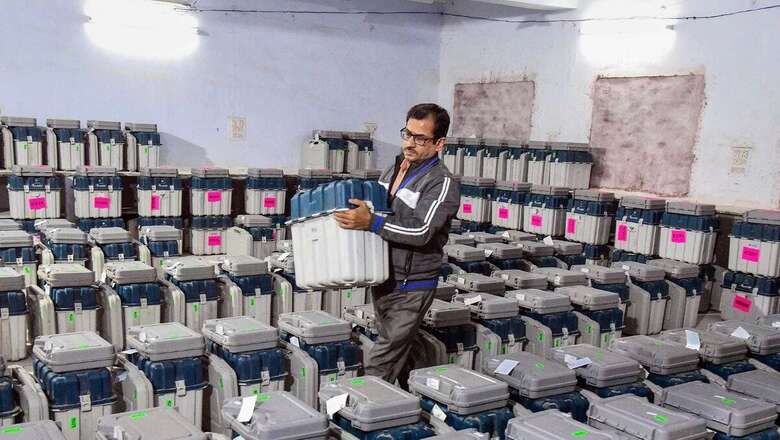
views
“Out of a total of 17,32,13,635 voters, 8,86,12,171 cast their votes for elections to the Parliament. The overall percentage was thus 51.15 which was by no means unsatisfactory.” That was how Sukumar Sen, the first Chief Election Commissioner of India, summed up the electoral participation in the first general elections, 1951-52 (Report on the First General Elections, 1951-52, Vol-1, P.131).
A voter turnout figure of 51.15 per cent would be considered poor, even outrageous today. The same was considered satisfactory then because it had previously been feared that adult suffrage would fail abjectly in India due to the bleak literacy rate (16.6 per cent in 1951). In the 1950s and 60s, the New Delhi-based Indian Adult Education Association (it still exists at the same address at 17-B, Indraprastha Estate) with S.C. Dutta as its General Secretary used to hold high-profile annual seminars on “Adult Education for Parliamentary Democracy” directed by Dr L.M. Singhvi.
However, actual experience revealed that electoral participation did not improve in sync with the rising literacy graph in the ensuing half a century. The polling percentage in three successive Lok Sabha elections – 1999 (59.99 per cent), 2004 (58.07 per cent) and 2009 (58.21 per cent) – failed to breach the 60 per cent mark despite tremendous advancement in literacy, the advent of electronic media, and strengthening of political organisation.
In the ongoing elections to the 18th Lok Sabha, below-par voter turnout has become a matter of discussion. From the rising mercury to people’s dipping interest in voting, poll pundits have tried to factor in almost everything. Even election planning has been questioned on the ground that two phases are scheduled on Fridays, and two on Saturdays, when voters might take advantage of long weekends to go on excursions.
The turnout figures given by the EC for the first two rounds are 66.14 per cent and 66.71 per cent respectively which signify a marginal dip compared to 2019. This is no doubt an improvement over the initial figures reported in the media. Election Commission of India – vide its press release dated May 3 – affirmed that it remained keenly focused on enhancing voter turnout. It listed a string of measures like collaboration with the BCCI during IPL 2024, vote day alert on Facebook, collaboration with the Postal department and nationalised/private banks, collaboration with the Ministries of Railways/Petroleum and Natural Gas/Civil Aviation, and tie-up with digital payment networks, food delivery platforms, television channels and podcast platforms etc. It appears that no stone has been left unturned in pursuit of alerting people to exercise their franchise.
In ancient Rome, Cato, the Elder also called Cato, the Censor (234-149) ended all his speeches regardless of the subject, with the singular phrase Carthago delenda est or delanda est Carthago (“Carthage must be destroyed”). So whatever one sees, hears or consumes should ideally deliver the message that one must vote, positively and ethically, and destroy the apathy towards voting.
Why and how did the polling percentage acquire such importance? Until the first decade of the 21st century, there was no such sensitivity around the subject. If one were to look at the historical figures of voter turnout in Lok Sabha elections, as given by the Election Commission of India, they breached the 60 per cent mark only five times in thirteen elections in 20th century – 61.04 per cent in 1967, 60.49 per cent in 1977, 64.01 per cent in 1984-85, 61.95 in 1989 and 61.97 per cent in 1998 (Electoral Statistics Pocket Book, 2021, P.48). As already told, in three successive elections to Lok Sabha in 1999, 2004 and 2009, the poll percentage remained below 60 per cent.
Thus, howsoever historic we might term certain elections, the electoral participation has ranged between ‘average’ to ‘fair’. Anything above 70 per cent can be rated as good, and above 75 per cent very good, never achieved at the pan-Indian level.
II
During the first fifty years or more, optimising the conduct of free and fair elections remained the priority for the ECI. Various electoral reforms, including Constitutional amendments, were enacted by the Parliament of India during this period. It is not true that the issue of participatory elections was completely lost upon the ECI. The then Chief Election Commissioner (CEC) S.P. Sen Varma, inspired by John Stuart Mills’ dictum that the polling places should be as numerous as to be within easy reach of every voter, made a dramatic increase in the number of polling stations for the Lok Sabha elections, 1971 (taking them to 3,42,944 in 1971 as against 2,67,555 in 1967), yet paradoxically the voters’ turnout fell sharply from 61.04 per cent in 1967 to 55.27 per cent in 1971.
By the early 21st century, a number of enforcement issues had been settled. By the late 1980s, observers got legal status, and the EC the authority to adjourn or countermand elections on grounds of booth capturing. The Election and Other Laws (Amendment) Act, 2003 made declaration of donations received by political parties mandatory, and made legal provision for allocation of equitable sharing of time on national carriers like DD and AIR etc, and free supply of electoral roll to candidates of recognised political parties etc. Electronic Voting Machines (EVMs) were universalised in the fourteenth Lok Sabha elections in 2004.
However, the average (or low) rate of voting in the three successive Lok Sabha elections in 1999, 2004 and 2009 made the Election Commission of India take notice. Several general and targeted interventions were envisaged to bridge the gap between enrollment and actual voting ahead of the Jharkhand Legislative Assembly elections towards the end of 2009. This led to the introduction of planned IEC (Information, Education and Communication) which subsequently came to be known as the SVEEP (Systematic Voter Education and Electoral Participation) programme. The Diamond Jubilee of the EC was celebrated on January 25, 2010. The theme adopted was ‘Greater Participation for Stronger Democracy’, making a strong pitch that ensuring free and fair elections through statutory and administrative measures was not enough, and increasing voter participation mattered.
On January 25, 2011, National Voters Day (NVD), coinciding with the foundation day of the Election Commission of India, was launched with fanfare. Its prime target group was young and first-time voters, who as experience showed, were lukewarm towards exercising their franchise. In 800,000 simultaneous events held across polling stations in India, voter ID card (EPIC) was handed to those who had turned 18 years old on January 1.
On the eve of the first NVD, while addressing an international conference on the theme of “Best Electoral Practices”, the then Chief Election Commissioner Dr S.Y. Quraishi delineated a reorientation in the EC’s approach in the following words-
“First, our Commission has very actively embraced the path of inclusive elections, in which voluntary participation of all sections of people in the electoral process is a cherished goal. The Commission does not want to leave voters’ participation to selective whims of political parties. We created a dynamic and proactive Voter Education and Electoral Participation Wing that would initiate scientifically planned interventions preceded by a comprehensive survey of Knowledge, Attitude, Behaviour and Practices among voters prior to elections.”
III
The Election Commission of India has progressively increased its stake in more participatory elections through a perennial voter education and facilitation programme. The Department Related Parliamentary Standing Committee report pertaining to the Demand for Grants (2023-24) of the Legislative Department (Ministry of Law and Justice) shows that Rs 75 crore was specifically allocated to the ECI for its voter awareness (SVEEP) programme. This was Rs 58.12 crore less than the ECI’s demand to the Ministry of Finance under that head (DRPSC on Personnel, Public Grievances, Law and Justice, Report No-130, P.27).
Over the last few years, the EC initiated several measures aimed at ease of voting. Assured minimum facilities in every polling station, all polling booths being located on ground floor, pick up and drop to persons with disabilities, and further home voting option for senior citizens above 85 years and persons with disabilities are some of them. The polling percentage in the last Lok Sabha elections (2019) reached a record high of 67.40.
Voters’ turnout is the ultimate test of voter education and facilitation programmes conducted by the Election Commission of India. Having boasted of rising voter participation as a success story of the EC, even a marginal dip could reflect poorly upon the Commission. That is exactly the peril of segregating electoral participation from political sentiments. As long as elections, even enrollment, are voluntary, polling figures are bound to be swayed by political sentiments. It might take a long time for voters to take polling as a sacred civic duty as a citizen of India.
Otherwise, a significant section of the electorate will vote when they strongly feel about a candidate and a political party. By some strange coincidence, the implementation of the SVEEP programme coincided with tectonic shifts in the political scenario and the rearrangement of political forces. The former benefitted from the latter buoying up the polling percentage. One could not deny the possibility of the voter education and facilitation programme getting caught in a downward political curve also. Thus, there is nothing to be disheartened by temporary setbacks, if any.
The voter turnout figure could not be entirely shielded from political sentiments. Admittedly, there are certain traditionally high-voting states like West Bengal, Tripura etc. That is a result of the sustained politicalisation of public life, which is not always a good thing.
The writer is author of the book ‘The Microphone Men: How Orators Created a Modern India’ (2019) and an independent researcher based in New Delhi. Views expressed in the above piece are personal and solely those of the author. They do not necessarily reflect News18’s views.















Comments
0 comment